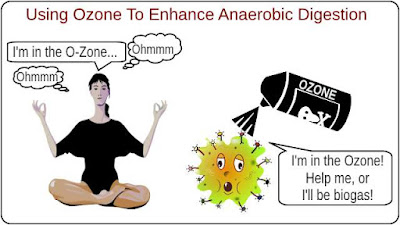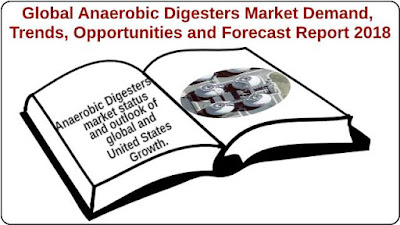Date: 13 March 2018: This is Issue 19 of the IADAB News Weekly, where we summarise the news of the week in the Anaerobic Digestion and Biogas Industry.
A brief summary roundup of the week's news follows, with an accent on biogas:
Alright, let’s get started with the detailed articles… (Scroll down for each extract and use the links to the full articles on each of the individual websites.)
The 57-year-old farmer also breeds hundreds of ducks, cattle and goats in one compound. Assisted by his wife, Tampar, 56, he boils hundreds of quail eggs every 30 minutes to then be sold in town. Despite the intensity of boiling, the couple showed not a single sign of concern over the supply of cooking gas.
“I don’t have any problem using the gas stove for a long period as it’s free of charge,” says Sutarman while pointing at the bright blue flame bursting out from the stove in the corner of his kitchen. He proudly showed how his stove produces a bright blue flame that most commercial liquefied petroleum gas (LPG) or cooking gas stoves cannot.
Such a quality of flame can only emerge from gas produced by his quails’ waste. The family can run their business more cheaply with a cooking gas supply thanks to waste from the 5,000 quails that they breed. Bird waste that the grandfather of seven initially considered useless can now be converted into an alternative energy source: biogas. via quailbiogas
According to a statement, the award means Audi Brussels is operating the world’s first certified CO2 neutral high volume production plant in the premium segment.
The German car maker’s Belgian facility covers all production processes and all other emissions generated at the plant either by renewable energies (approximately 95%), or compensates for them though environmental projects (5%).
Biogas is playing a crucial role in the facility’s strive to carbon neutrality, fulfilling the heating needs for the plant itself as well as the offices on site. via AudiBrusselsCO2
KUALA LUMPUR (March 14): VSolar Group Bhd which recently scrapped a plan to build a solar power generation plan with Universiti Teknologi Malaysia (UTM), citing the poor rates of return, is planning to stop its solar business and concentrate on its renewable energy (RE) business.
Its group executive director Edward Leung Kok Keong said the group currently still has its 1MW generating solar power plant in Simpang Pulai, Perak and would stop at that.
“We are stopping at that (the 1MW solar power plant in Simpang Pulai) because our financial assessment indicated that the payback period is too long and the financials does not make sense.
“So we are staying away from solar and we are now looking at another alternative which is RE technology that we could invest in, because the financials make sense,” he told reporters after the group's extraordinary general meeting today.
VSolar expects its 10MW biomass/biogas energy generation plant, which it has entered into a joint venture with a Singapore firm KRU Energy Asia Pte Ltd, Rangkaian Iltizam Sdn Bhd which is KRU’s subsidiary, and a local citizen Kenneth Lee Wai Tong in August last year, to start contributing to the group’s revenue in late 2019.
Leung said VSolar has submitted its application to the Sustainable Energy Development Authority Malaysia (SEDA) and is now waiting for approval before the group can kick-start the project. via VSolarREbusiness
The objective of this paper is to better understand how thermochemical processing conditions affect the capacity of biochars derived from AD fiber to adsorb H2S from biogas.
AD fiber was pyrolyzed in an electric tube reactor at temperatures up to 600 °C and 60 min. The chars were employed for H2S scrubbing tests from a synthetic biogas.
Results showed that the chars’ capacity for H2S removal is comparable to that of activated carbon. via Charcoalhydrogensulfide
A brief summary roundup of the week's news follows, with an accent on biogas:
First, it is good to start with an unusual anaerobic digestion plant feedstock, as it is a reminder that there are many untapped materials which can be used to make biogas. In the case, it is about a farmer who makes a nice profit from his home produced quail-waste based biogas. Many others could be making biogas like this...
Second, using biogas as a sustainable renewable vehicle fuel source is helping Audi's Brussels plant go CO2 neutral.
Third, VSolar in Malaysia foresee better profitability in the future from biogas than solar power. In future they are going to focus on Renewable Energy from biomass. The business is investing in bio-energy, and expects its new 10MW biogas energy to contribute to company profits in late 2019
Fourth, a scientific research paper describes how charcoal made from anaerobically digested dairy fibre, can be used for removal of hydrogen sulphide within biogas plants. The study found that the quality of the char produced was a good as activated carbon. This looks like a great use for the digestate fibre from biogas plants.
Fifth, the Finnish Government is continuing to support increased biogas production, with investment in a new anaerobic digestion facility. Its all part of their plans to increase the use of renewable energy in a sustainable way, so that its share of the total, will rise to more than 50% during the 2020s.
Finally, Reading buses are going green, and no doubt air-pollution rates will drop as a result. Reading Buses are now testing 17 Scania double-decker biogas buses in service.
The following is our intro video. Watch the intro video below, for a taster of what you will read if you scroll down below the video:
1 - Continuous profit from quail-waste based biogas
Sutarman can never hide his smile as his quail egg business gradually grows. He can sell an average of 30 to 40 kilograms of eggs per day.
The 57-year-old farmer also breeds hundreds of ducks, cattle and goats in one compound. Assisted by his wife, Tampar, 56, he boils hundreds of quail eggs every 30 minutes to then be sold in town. Despite the intensity of boiling, the couple showed not a single sign of concern over the supply of cooking gas.
“I don’t have any problem using the gas stove for a long period as it’s free of charge,” says Sutarman while pointing at the bright blue flame bursting out from the stove in the corner of his kitchen. He proudly showed how his stove produces a bright blue flame that most commercial liquefied petroleum gas (LPG) or cooking gas stoves cannot.
Such a quality of flame can only emerge from gas produced by his quails’ waste. The family can run their business more cheaply with a cooking gas supply thanks to waste from the 5,000 quails that they breed. Bird waste that the grandfather of seven initially considered useless can now be converted into an alternative energy source: biogas. via quailbiogas
2 - Biogas helps Audi Brussels plant go CO2 neutral
Audi Brussels has been awarded a CO2 neutral certificate by the Belgian testing company Vinçotte.According to a statement, the award means Audi Brussels is operating the world’s first certified CO2 neutral high volume production plant in the premium segment.
The German car maker’s Belgian facility covers all production processes and all other emissions generated at the plant either by renewable energies (approximately 95%), or compensates for them though environmental projects (5%).
Biogas is playing a crucial role in the facility’s strive to carbon neutrality, fulfilling the heating needs for the plant itself as well as the offices on site. via AudiBrusselsCO2
3 - VSolar to focus on RE business, expects 10MW biogas energy to contribute in late 2019
KUALA LUMPUR (March 14): VSolar Group Bhd which recently scrapped a plan to build a solar power generation plan with Universiti Teknologi Malaysia (UTM), citing the poor rates of return, is planning to stop its solar business and concentrate on its renewable energy (RE) business.
Its group executive director Edward Leung Kok Keong said the group currently still has its 1MW generating solar power plant in Simpang Pulai, Perak and would stop at that.
“We are stopping at that (the 1MW solar power plant in Simpang Pulai) because our financial assessment indicated that the payback period is too long and the financials does not make sense.
“So we are staying away from solar and we are now looking at another alternative which is RE technology that we could invest in, because the financials make sense,” he told reporters after the group's extraordinary general meeting today.
VSolar expects its 10MW biomass/biogas energy generation plant, which it has entered into a joint venture with a Singapore firm KRU Energy Asia Pte Ltd, Rangkaian Iltizam Sdn Bhd which is KRU’s subsidiary, and a local citizen Kenneth Lee Wai Tong in August last year, to start contributing to the group’s revenue in late 2019.
Leung said VSolar has submitted its application to the Sustainable Energy Development Authority Malaysia (SEDA) and is now waiting for approval before the group can kick-start the project. via VSolarREbusiness
4 - Charcoal from anaerobically digested dairy fibre for removal of hydrogen sulfide within biogas
Anaerobically digested fibrous solid (AD fiber) is an abundant material that offers potential to produce value-added products such as biochar.The objective of this paper is to better understand how thermochemical processing conditions affect the capacity of biochars derived from AD fiber to adsorb H2S from biogas.
AD fiber was pyrolyzed in an electric tube reactor at temperatures up to 600 °C and 60 min. The chars were employed for H2S scrubbing tests from a synthetic biogas.
Results showed that the chars’ capacity for H2S removal is comparable to that of activated carbon. via Charcoalhydrogensulfide
5 - Finnish Government supports increased biogas production
The Ministry of Economic Affairs and Employment has granted Gasum €7.83 million in ‘Bioeconomy and clean solutions’ key project support for increased biogas production.
Developing the biogas market and the transport use of natural gas and increasing biogas production capacity are key elements of the Gasum strategy. The company has examined the possibility of constructing a biogas plant in Munkkaa, Lohja, in Southern Finland.
The objective of the Government’s Bioeconomy and clean solutions key projects is to increase the use of renewable energy in a sustainable way so that its share will rise to more than 50% during the 2020s. via Finnishbiogas
Please do, Like, subscribe and leave a comment. Also - Join our mailing list, and YouTube Channel!
The objective of the Government’s Bioeconomy and clean solutions key projects is to increase the use of renewable energy in a sustainable way so that its share will rise to more than 50% during the 2020s. via Finnishbiogas
6 - Reading Buses Testing 17 Scania Double-Decker Biogas Buses
Scania has completed delivery of 17 new biogas-powered Double-Decker buses to Reading Buses (UK), according to a new press release. The new biogas-powered buses are being put into service on Reading’s reportedly busiest route, the “Purple 17.” via ReadingBusesPlease do, Like, subscribe and leave a comment. Also - Join our mailing list, and YouTube Channel!













